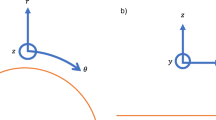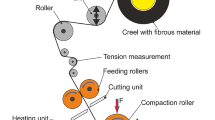Abstract
The conventional repairing of CFRP (continuous fiber-reinforced polymer composites) includes complicated steps of patching, splicing, repairing, and post-curing. Intensive labor work needs to be conducted, and poor surface quality and weak interfacial adhesion are usually observed. This work mainly introduces an in situ online repairing method using AM (additive manufacturing) facilitated composite fabrication. With the advances of the robotic-assisted AM process, the surface roughness and accuracy during the repairing process can be evaluated online upon layer-by-layer process. In order to fulfill the efficient and on-site requirements for repairing damage in structural components, this study explores the method including in situ repairing, laser point clouds online collection, and repairing path planning based on multi-axial additive manufacturing of composites. A repair algorithm is proposed incorporating point clouds collection, measurement evaluation, and path planning. Furthermore, relevant mechanical measurements have been conducted, so as to assess the interface degree of recovery. A rapid online evaluation and surface conformal repairing method have been proposed to overcome the technical bottleneck of in situ automatic repairing of damaged composites. It expands the application of multi-axial robot-assisted CFRP AM.





















Similar content being viewed by others
Availability of data and material
This work has no available data.
Code availability
This work has no available code.
References
Yuan S, Li S, Zhu J, Tang Y (2021) Additive manufacturing of polymeric composites from material processing to structural design. Compos Part B Eng 219:108903
Eichenhofer M, Wong JCH, Ermanni P (2017) Continuous lattice fabrication of ultra-lightweight composite structures. Addit Manuf 18:48–57
Parandoush P, Lin D (2017) A review on additive manufacturing of polymer-fiber composites. Compos Struct 182:36–53
Fasel U, Keidel D, Baumann L, Cavolina G, Eichenhofer M, Ermanni P (2020) Composite additive manufacturing of morphing aerospace structures. Manuf Lett 23:85–88
Xie F, Chen L, Li Z, Tang K (2020) Path smoothing and feed rate planning for robotic curved layer additive manufacturing. Robot Comput Integr Manuf 65:101967
Lu L, Hou J, Yuan S, Yao X, Li Y, Zhu J (2023) Deep learning-assisted real-time defect detection and closed-loop adjustment for additive manufacturing of continuous fiber-reinforced polymer composites. Robot Comput Integr Manuf 79:102431
Katnam KB, Da Silva LFM, Young TM (2013) Bonded repair of composite aircraft structures: a review of scientific challenges and opportunities. Prog Aerosp Sci 61:26–42
Baker A (1999) Bonded composite repair of fatigue-cracked primary aircraft structure. Compos Struct 47:431–443
Soutis D-MDC, Goutas P (1999) Compressive behaviour of CFRP laminates repaired with adhesively bonded external patches. Compos Struct 45:289–301
Fidan I, Imeri A, Gupta A, Hasanov S, Nasirov A, Elliott A, Alifui-Segbaya F (2019) Nanami N The trends and challenges of fiber reinforced additive manufacturing. Int J Adv Manuf Technol 102:1801–1818
Al-Musaibeli H, Ahmad R (2022) A path planning method for surface damage repair using a robot-assisted laser cladding process. Int J Adv Manuf Technol 122:1259–1279
Chuan Zhenga DY, Haoc Weidong, Qiaod Tieliang, Zhaoquan Tane J, Jinf, (2021) Smooth path generation method of laser cladding bit repair robot based on 3D automatic measurement of wear surface point cloud. J Phys Conf Ser 1939:1742–6596
K. Okarma, and Jarosław Fastowicz, Computer vision methods for non-destructive quality assessment in additive manufacturing. In Progress in Computer Recognition systems, edited by Robert Burduk, Marek Kurzynski, and Michał Wozniak, (2020) 11–20
García-Díaz A, Panadeiro V, Lodeiro B, Rodríguez-Araújo J, Stavridis J, Papacharalampopoulos A, Stavropoulos P (2018) OpenLMD, an open source middleware and toolkit for laser-based additive manufacturing of large metal parts. Robot Comput Integr Manuf 53:153–161
L. Chen, Xiling Yao, Peng Xu, Seung Ki Moon, and Guijun, Surface monitoring for additive manufacturing with in-situ point cloud processing, international conference on control. Automation and Robotics and Computer-Integrated Manufacturing, (2020) 196–201
Xu P, Yao X, Chen L, Zhao C, Liu K, Moon SK, Bi G (2022) In-process adaptive dimension correction strategy for laser aided additive manufacturing using laser line scanning. J Mater Process Technol 303:117544
Chen L, Yao X, Xu P, Moon SK, Bi G (2020) Rapid surface defect identification for additive manufacturing with in-situ point cloud processing and machine learning. Virtual Phys Prototyp 16:50–67
Svetlizky D, Das M, Zheng B, Vyatskikh AL, Bose S, Bandyopadhyay A, Schoenung JM, Lavernia EJ, Eliaz N (2021) Directed energy deposition (DED) additive manufacturing: physical characteristics, defects, challenges and applications. Mater Today 49:271–295
Lian G, Zhang Y, Zhang H, Huang X, Chen C, Jiang J (2019) Investigation of geometric characteristics in curved surface laser cladding with curve path. Metals 9:947
Imam HZ, Zheng Y, Ahmad R (2020) An efficient tool-path planning approach for repair of cylindrical components via laser cladding. J Remanuf 11:137–146
J. Jiang, Y. Ma 2020 Path planning strategies to optimize accuracy, quality, build time and material use in additive manufacturing: a review Micromachines 11
Liu J, Sun W, Huang Y (2021) An algorithm for trajectory planning of complex surface parts for laser cladding remanufacturing. Proc Inst Mech Eng B J Eng Manuf 235:2025–2032
Li Y, Chen T, Liu D (2020) Path planning for laser cladding robot on artificial joint surface based on topology reconstruction. Algorithms 13:93
M. Cakir, C. Deniz, High precise and zero-cost solution for fully automatic industrial robot TCP calibration, Industrial Robot, ahead-of-print (2019).
Han X-F, Jin JS, Wang M-J, Jiang W, Gao L, Xiao L (2017) A review of algorithms for filtering the 3D point cloud. Signal Process Image Commun 57:103–112
D.P.K.J.L. Ba, ADAM: a method for stochastic optimization, arXiv preprint arXiv:1412.6980, (2014) 1, 3, 4, 7
Lee DT, Schachter BJ (1980) Two algorithms for constructing a Delaunay triangulation. Int J Comput Inf Sci 9:219–242
Guibas L, Stolfi J (1985) Primitives for the manipulation of general subdivisions and the computation of Voronoi. ACM Trans Graph 4:74–123
Abdi H, Williams LJ (2010) Principal component analysis. Wiley Interdiscip Rev Comput Stat 2:433–459
BD Han, HD Kim, DS Park Method for preparing silicon nitride ceramic with high strength and toughness, in, 2001
Guo A, Kong D, Zhou X, Kong H, Qu P, Wang S, Wang H, Hu Y (2022) Method for preparing damage-resistant 3D-printed ceramics via interior-to-exterior strengthening and toughening. Addit Manuf 60:103272
A.-N. Chen, LuCheng, Li-JinWu, Jia-MinLiu, Rong-ZhenChen, ShuangChen, YingWen, Shi-FengLi, Chen-HuiShi, Yu-Sheng, TEM analysis and mechanical strengthening mechanism of MnO2 sintering aid in selective laser sintered porous mullites, Journal of Alloys and Compounds: An Interdisciplinary Journal of Materials Science and Solid-state Chemistry and Physics, 809 (2019).
Acknowledgements
The authors would like to acknowledge the financial support from the National Key R&D Program of China (2022YFB4602001, 2022YFB3402200), the Key Laboratory Fund for equipment pre-research, Practice and Innovation Funds for Graduate Students of Northwestern Polytechnical University, NSFC (52375380), and the Key Program of NSFC (92271205).
Funding
This work is supported by the National Key R&D Program of China (2022YFB4602001, 2022YFB3402200), the Key Laboratory Fund for equipment pre-research, Practice and Innovation Funds for Graduate Students of Northwestern Polytechnical University, NSFC (52375380), and the Key Program of NSFC (92271205).
Author information
Authors and Affiliations
Contributions
Jie Hou: concept, coding, writing, experiment.
Lu Lu: concept, coding, writing, experiment.
Shangqin Yuan: experiment, review, editing.
Ruikang Zhai: editing, review.
Yifan Hu: review.
Dongrui Wang: review.
Xiangfan Nie: review.
Fang Li: review.
Heye Xiao: review, funding.
Corresponding authors
Ethics declarations
Ethics approval
Not applicable.
Consent to participate
Not applicable.
Consent for publication
Not applicable.
Conflict of interest
The authors declare no competing interests.
Additional information
Publisher's Note
Springer Nature remains neutral with regard to jurisdictional claims in published maps and institutional affiliations.
Appendix
Appendix
Nomenclature | |
|---|---|
Abbreviation | Definition |
CFRP | Continuous fiber-reinforced polymer |
AM | Additive manufacturing |
DED | Directed energy deposition |
NDT | Non-destructive testing |
NURBS | Non-uniform rational B-splines |
TCP | Tool center point |
DT algorithm | Delaunay triangulation algorithm |
PCA | Principal component analysis |
RMSE | Root mean square error |

Rights and permissions
Springer Nature or its licensor (e.g. a society or other partner) holds exclusive rights to this article under a publishing agreement with the author(s) or other rightsholder(s); author self-archiving of the accepted manuscript version of this article is solely governed by the terms of such publishing agreement and applicable law.
About this article
Cite this article
Hou, J., Lu, L., Yuan, S. et al. In situ repairing of continuous fiber-reinforced thermoplastic composite via multi-axial additive manufacturing. Int J Adv Manuf Technol 132, 853–872 (2024). https://doi.org/10.1007/s00170-024-13381-6
Received:
Accepted:
Published:
Issue Date:
DOI: https://doi.org/10.1007/s00170-024-13381-6




